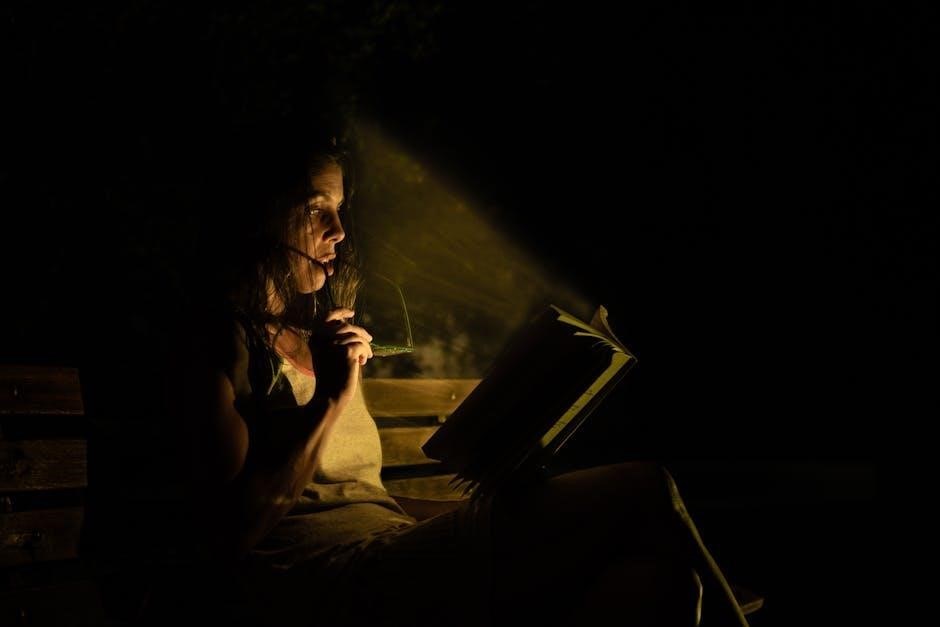“One Hundred Years of Solitude” by Gabriel García Márquez is a masterpiece of magical realism, exploring themes of solitude, time, and family through the Buendía clan’s captivating tale.
1.1 Overview of the Novel
“One Hundred Years of Solitude” is a captivating tale of the Buendía family, set in the mystical town of Macondo. Founded by José Arcadio Buendía and Úrsula, Macondo evolves through cycles of prosperity, war, and decay. The novel explores themes of solitude, time, and family, blending magical realism with historical and cultural elements. Through seven generations, the Buendías face love, loss, and fate, revealing the inevitable repetition of human experiences. This epic story weaves magic and reality, creating a timeless portrait of solitude and existence.
1.2 The Author: Gabriel García Márquez
Gabriel García Márquez, a Colombian novelist, is renowned for his magical realism style. Born in 1927 in Aracataca, Colombia, he drew inspiration from his childhood, blending myths, history, and fantasy. His works often explored solitude, love, and the cyclical nature of time. A Nobel Prize laureate in 1982, Márquez became a global literary icon. “One Hundred Years of Solitude” is his magnum opus, cementing his legacy as a master of contemporary literature and a key figure in the Latin American Boom.
1.3 Historical Context of the Novel
Gabriel García Márquez wrote “One Hundred Years of Solitude” against the backdrop of Colombia’s turbulent history, including civil wars and political upheaval. Drawing from his native Aracataca’s experiences, he wove in elements of colonialism, modernization, and social change. The novel reflects the broader Latin American context, blending myths, history, and cultural identity. This historical richness adds depth to Macondo’s story, mirroring the region’s struggles with isolation, progress, and the cyclical nature of time.

Plot Overview
“One Hundred Years of Solitude” traces the rise and fall of Macondo, a mystical town founded by José Arcadio Buendía and Úrsula. The novel follows the Buendía family through generations, exploring themes of love, solitude, and the cyclical nature of time, blending magical realism with the town’s prosperity and eventual demise.
2.1 Founding of Macondo
Macondo, a mystical town, was founded by José Arcadio Buendía and his wife, Úrsula, after fleeing their home due to a tragic incident. Seeking solitude and a fresh start, they established the town in a remote, uncharted region. Initially, Macondo was a small, isolated community, untouched by the outside world, where the Buendía family hoped to escape their past and build a new life. The town’s founding marked the beginning of a cycle of prosperity, conflict, and eventual decline, setting the stage for the Buendía family’s extraordinary saga.
2.2 The Buendía Family Tree
The Buendía family tree is central to the novel, spanning multiple generations. Founded by José Arcadio Buendía and Úrsula, the family’s lineage is marked by repeated names and generational cycles. Each Buendía inherits traits and fate from their ancestors, creating a sense of inevitability. The tree reflects the novel’s themes of cyclical time and inescapable destiny, as the family’s history repeats itself through love, loss, and solitude. The intricate web of relationships underscores the connection between individual and collective fate in Macondo.
2.3 Key Events in the Novel
The novel unfolds through pivotal events that shape Macondo’s destiny. The arrival of gypsies introduces magical elements, while José Arcadio Buendía’s inventions spark curiosity. The discovery of insomnia and the creation of parchment to preserve memory mark a turning point. Colonel Aureliano Buendía’s wars for liberalism highlight political turmoil, and the arrival of modernity brings both progress and exploitation. The eventual decline of Macondo and the Buendía family’s demise culminate in a tragic yet inevitable conclusion, reflecting the cyclical nature of time and fate.
2.4 The Demise of Macondo
The demise of Macondo is a gradual and inevitable process, mirroring the decline of the Buendía family. The town, once vibrant and full of life, succumbs to internal decay and external forces. A devastating cyclone symbolizes the irreversible fate, erasing Macondo from existence. The final Buendía, Aureliano, deciphers the family’s history just as the town disappears, leaving no trace of its once-thriving civilization. This tragic conclusion underscores the cyclical nature of time and the inescapable fate that binds both the family and their beloved town.

Themes in “One Hundred Years of Solitude”
The novel explores solitude, time’s cyclical nature, progress, sexuality, and the clash between magic and reality, weaving these themes into a rich tapestry of human experience.
3.1 Solitude and Isolation
Solitude is the central theme of the novel, deeply embedded in the lives of the Buendía family and the town of Macondo. Each character struggles with isolation, whether through personal choice or circumstance. José Arcadio Buendía’s inventiveness and Úrsula’s resilience highlight their loneliness amidst a fragmented community. The town’s physical isolation mirrors the emotional detachment of its inhabitants. This theme reflects the human condition, where solitude is both a curse and a form of self-discovery, ultimately shaping the characters’ destinies and the town’s fate.
3.2 The Cyclical Nature of Time
The novel portrays time as cyclical rather than linear, with events repeating across generations. The Buendía family’s history is marked by recurring patterns of love, war, and invention. Characters with similar names and destinies illustrate this cycle, emphasizing inevitability and fate. Time folds in on itself, blending past, present, and future, creating a sense of inescapable repetition. This cyclical structure underscores the futility of progress and the inevitability of Macondo’s decline, reflecting the universal human experience of being trapped in time’s relentless loop.
3.3 Progress and Civilization

The novel critiques the notion of progress and civilization through Macondo’s fluctuating fortunes. The town’s initial isolation and subsequent exposure to modernity, such as railroads and cinema, symbolize the intrusive force of progress. However, these advancements often lead to chaos and exploitation, highlighting the illusion of societal improvement. The cyclical decline of Macondo underscores the futility of progress, as technological and cultural advancements fail to bring lasting prosperity or harmony to its inhabitants, ultimately revealing the destructive side of unchecked modernization and external influence.
3.4 Propriety, Sexuality, and Incest
The novel explores themes of propriety, sexuality, and incest through the Buendía family’s complex relationships. Societal norms clash with desires, as seen in forbidden loves and illicit affairs. Incest, particularly among the Buendías, reflects a cursed fate tied to their isolation. These themes highlight the tension between moral expectations and primal instincts, illustrating how the family’s internal turmoil mirrors the broader human struggle with societal constraints and personal freedoms, ultimately leading to devastating consequences that echo across generations.
3.5 Magic vs. Reality
Magic vs. Reality is a central theme in “One Hundred Years of Solitude”, blending the fantastical with the mundane. The town of Macondo experiences magical events like levitation and alchemy alongside ordinary life struggles. This fusion challenges distinctions between the real and the imagined, creating a unique narrative where the extraordinary becomes ordinary. García Márquez’s magical realism explores how reality is shaped by individual and collective perceptions, making the surreal an integral part of the Buendía family’s history and the world they inhabit.

Magical Realism in the Novel
Magic realism defines “One Hundred Years of Solitude”, blending fantasy with everyday life. García Márquez masterfully crafts a world where the surreal and mundane coexist seamlessly. This style captivates readers.
4.1 Definition and Examples
Magical realism is a literary style blending realistic descriptions of everyday life with magical elements. In “One Hundred Years of Solitude”, this is evident in events like José Arcadio Buendía’s encounters with gypsies, RemediosBuendía ascending to heaven, and the insomnia plague that erases memory. These fantastical occurrences are presented as normal, creating a seamless blend of the extraordinary and the mundane. This unique narrative approach captures the essence of García Márquez’s storytelling, immersing readers in Macondo’s enchanting yet isolating world. The technique underscores themes of isolation and the cyclical nature of time.
4.2 Role in Shaping the Narrative
Magical realism in “One Hundred Years of Solitude” serves as a narrative device to explore deeper truths about human nature, history, and destiny. By intertwining the fantastical with the mundane, García Márquez creates a unique storytelling atmosphere that captivates and challenges readers. This style allows the Buendía family’s struggles with solitude, time, and fate to resonate universally. The blending of magic and reality not only enriches the narrative but also mirrors the cyclical and often mysterious nature of life, making Macondo’s story both enchanting and thought-provoking. This approach underscores the novel’s timeless appeal and depth.

Family and Fate in the Buendía Family
The Buendía family is central to the novel, with each generation grappling with inherited curses and recurring patterns of solitude, love, and tragedy, shaping their destiny.
5.1 José Arcadio Buendía and Úrsula
José Arcadio Buendía, the visionary founder of Macondo, embodies innovation and curiosity, while his wife, Úrsula, represents stability and tradition. Their union establishes the Buendía legacy, blending progress with enduring values. José’s inventive spirit drives Macondo’s growth, yet his obsession often leads to chaos. Úrsula’s practicality and strength anchor the family, ensuring survival through crises. Together, they set the stage for the Buendías’ cursed fate, their contrasting traits shaping the family’s destiny and the town’s prosperity.
5.2 The Curse of the Buendías
The Buendía family is haunted by an inherited curse of solitude and tragic destiny. Stemming from their isolation and inability to connect deeply, the curse manifests through repeated patterns of loss, madness, and premature deaths. It is tied to their inability to escape the cyclical nature of time, leading to a inevitable downfall. The curse is both a literal and metaphorical force, shaping their fate and ensuring their ultimate isolation, even as they seek connection and meaning in a world that seems destined to forget them.
5.3 Repeated Names and Generational Cycles
The Buendía family’s history is marked by recurring names, creating a sense of inevitability and cyclical fate. Names like José Arcadio and Aureliano repeat across generations, symbolizing the inescapable patterns of their destiny. This repetition underscores the novel’s theme of time as a cycle, where events and experiences echo through the family’s history. The repeated names also highlight the interconnectedness of the Buendías’ lives, as each generation relives the triumphs and tragedies of their predecessors, trapped in a cycle that shapes their individual and collective fates.

Political and Historical Context
“One Hundred Years of Solitude” reflects Colombia’s turbulent history, including colonialism, civil wars, and foreign intervention, shaping Macondo’s rise and fall within a politically charged landscape.
6.1 Macondo’s Isolation and Prosperity
Macondo, founded by José Arcadio Buendía and Úrsula, begins as a secluded town, untouched by the outside world. Its isolation fosters unique traditions and inventions, leading to prosperity. The town flourishes with gypsies bringing new knowledge and technologies, sparking innovation. However, this isolation also breeds internal conflicts and a disconnection from broader historical events. Macondo’s prosperity peaks during a banana boom, attracting outsiders and modernity, but this period is short-lived, as political turmoil and exploitation sow seeds of decline, ultimately reflecting Colombia’s turbulent history.
6.2 War and Civil Strife in Macondo
Macondo’s prosperity is disrupted by war and civil strife, driven by political instability and external exploitation. Colonel Aureliano Buendía leads rebellions against oppressive regimes, reflecting the turmoil of Colombia’s history. The town becomes a battleground, suffering destruction and loss. The arrival of foreign corporations and the subsequent Banana Massacre exemplify the brutal suppression of dissent. These events highlight the cyclical nature of violence and the devastating impact on Macondo’s inhabitants, mirroring the broader historical context of Latin America’s struggles with power and oppression.

Stylistic Elements
Gabriel García Márquez’s novel blends magical realism with vivid, cyclical narratives, creating a unique style that merges the extraordinary with everyday life in Macondo’s captivating world.
7.1 Narrative Structure
The novel’s narrative structure is non-linear, blending past, present, and future seamlessly. Magical realism intertwines with historical events, creating a cyclical timeline where time appears fluid. The Buendía family’s history repeats across generations, emphasizing themes of solitude and fate. The narrative jumps through time, exploring the interconnectedness of events and the inevitability of the family’s destiny. This unique structure reflects the isolation of Macondo and the timeless quality of its inhabitants’ experiences, making the story both captivating and deeply reflective of human existence.
7.2 Symbolism in the Novel
The novel is rich in symbolism, with elements like the town of Macondo and the Buendía family serving as metaphors for broader human experiences. The recurring presence of gypsies symbolizes the search for knowledge and the unknown, while the insomnia plague represents the loss of collective memory. The cyclical nature of time is mirrored in the repetition of names and events, emphasizing fate’s inevitability. These symbols weave together to create a layered narrative that explores solitude, history, and the human condition, making the novel a profound exploration of existential themes.

Critical Reception and Reviews
“One Hundred Years of Solitude” received widespread critical acclaim, praised for its magical realism and profound exploration of human themes. It solidified García Márquez’s reputation as a literary giant.
8.1 Initial Reception of the Novel
Upon its release, “One Hundred Years of Solitude” garnered widespread critical acclaim for its innovative storytelling and magical realism. Reviewers praised its unique blend of fantasy and reality, hailing it as a groundbreaking work in Latin American literature. The novel’s complex themes and intricate narrative structure resonated deeply with readers, establishing it as a seminal text of the Latin American Boom. Its success was immediate, solidifying García Márquez’s reputation as a literary visionary and cementing the novel’s status as a modern classic.
8.2 Modern Critical Analysis
Modern scholars continue to explore “One Hundred Years of Solitude” through diverse lenses, analyzing its themes of isolation, cyclical time, and the human condition. Critics highlight the novel’s universal appeal, transcending cultural boundaries. The interplay of magic and reality remains a focal point, underscoring the richness of Márquez’s narrative technique. Contemporary readings also emphasize the novel’s political undertones and its critique of colonialism, further enriching its depth and relevance in today’s academic discourse.

Impact and Legacy
“One Hundred Years of Solitude” has profoundly influenced world literature, popularizing magical realism and inspiring countless adaptations. Its global appeal endures, making it a timeless classic.
9.1 Cultural Impact
“One Hundred Years of Solitude” revolutionized Latin American literature, popularizing magical realism. Its unique narrative style and universal themes have inspired writers globally. The novel has become a cultural icon, shaping identity and sparking discussions on isolation, time, and family. Its influence extends beyond literature, inspiring films, art, and music. As a required text in schools worldwide, it continues to resonate, reflecting shared human experiences and fostering cross-cultural understanding.
9.2 Popularity and Translations
“One Hundred Years of Solitude” is a global phenomenon, translated into over 30 languages and selling millions of copies. Its universal appeal lies in its rich, imaginative storytelling. The novel’s popularity has endured for decades, making it a staple in literary canons. Translations have introduced Macondo’s magical world to diverse audiences, ensuring García Márquez’s work remains accessible and influential worldwide. This widespread reach solidifies its status as a timeless classic of world literature.
“One Hundred Years of Solitude” is a profound exploration of human existence, blending magical realism with universal themes. Its legacy as a literary masterpiece endures, captivating readers globally with its timeless story of love, solitude, and the cyclical nature of time, leaving an indelible mark on world literature.
10.1 Final Thoughts on the Novel
“One Hundred Years of Solitude” is a mesmerizing tale of love, isolation, and the cyclical nature of time. Through the Buendía family’s journey, García Márquez masterfully blends magical realism with profound human truths. The novel’s exploration of solitude, family curses, and the passage of time leaves readers with a lasting sense of wonder and reflection. Its acclaim as a literary masterpiece is well-deserved, as it continues to captivate audiences with its rich, poignant, and unforgettable storytelling.
